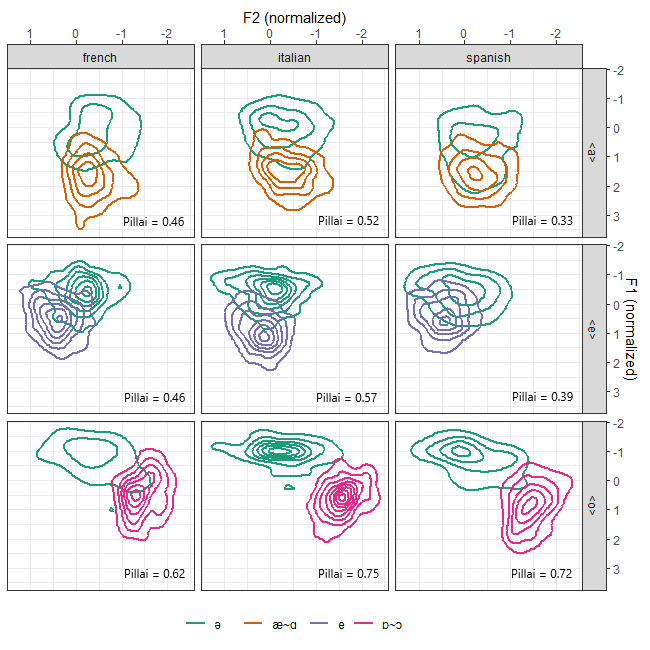Unstressed vowels in learner speech: exploring the IPCE-IPAC data

1. Introduction
English is characterized by presenting vowel reduction in unstressed vowels, usually represented phonologically as /ə/. This phonological phenomenon has been proven to be difficult to reproduce by learners of L1s that do not present this spectral cue to word stress (Flege & Bohn, 1989; Lee et al., 2006)1. The present study seeks to describe the behavior of unstressed vowels in the L2 English of native speakers of three L1 romance languages which do not present phonological vowel reduction: Italian, French, and Spanish.
2. Methodology
Audio recordings of a reading out loud task from the Interphonology of Contemporary English corpus (IPCE-IPAC, Herry-Bénit et al., forthcoming)2 were used for the analysis. Read-aloud speech was selected for our analysis because 1. it provides comparable data of vowels in identical phonological contexts across all speakers, and 2. it can be used as a basis to evaluate the influence of spelling in the pronunciation of reduced vowels. Data from 15 ItalianL1, 15 FrenchL1 and 10 SpanishL1 speakers were analyzed. Phoneme alignment of recordings was performed automatically using WebMaus (Kisler et al., 2017)3, then manually corrected. Stressed and unstressed vowels were annotated according to their graphic forms: ⟨e⟩ → /e/ and /ə/, ⟨a⟩ → /æ~ɑː/ and /ə/, and ⟨o⟩ → /ɒ~ɔː/ and /ə/. Some grapheme combinations were excluded from analyses to control for rhotacization (⟨ar⟩, ⟨er⟩, ⟨or⟩), velarization (⟨al⟩, ⟨el, le⟩, ⟨ol⟩), and palatalization (⟨ion⟩, ⟨ian⟩). F1 and F2 values were then extracted and normalized for inter-speaker comparison (Lobanov, 1971)4. Duration data were also extracted for all vowels. Pairwise comparisons of the vowel space of stressed and unstressed versions of the same graphic vowels were performed in order to evaluate their discrimination. This was done by comparing speaker-specific Pillai scores (Hay et al., 2006; Nycz & Hall-Lew, 2014)5;6 obtained from MANOVA tests using the formula (F1, F2, duration) ~ phoneme.
3. Results
Some L1-specific trends arise when looking averaged Pillai scores: Spanish speakers present the highest level of overlap between stressed and unstressed versions of ⟨a⟩ and ⟨e⟩ (higher Pillai scores = lower overlap), followed by French speakers and then Italian speakers (cf. also Figure 1). There is a considerably lower degree of overlap between stressed and unstressed ⟨o⟩ across all three L1 groups. However, the averages shown here display important standard deviations, which suggests that there is intra-L1 variation in stressed-unstressed vowel overlap.
| ⟨ˈa⟩ vs. ⟨a⟩ (/æ~ɑː/ vs. /ə/) | ⟨ˈe⟩ vs. ⟨e⟩ (/e/ vs. /ə/) | ⟨ˈo⟩ vs. ⟨o⟩ /ɒ~ɔː/ vs. /ə/) | ||||
|---|---|---|---|---|---|---|
| L1 | x̄ Pillai score | sd | x̄ Pillai score | sd | x̄ Pillai score | sd |
| Italian | 0,52 | 0,138 | 0,57 | 0,093 | 0,75 | 0,087 |
| French | 0,46 | 0,143 | 0,46 | 0,147 | 0,62 | 0,134 |
| Spanish | 0,33 | 0,109 | 0,39 | 0,112 | 0,72 | 0,107 |
When analyzed in isolation, duration data was consistently longer for stressed vowels across all L1s, showing that duration is a phonetic cue used to mark stress by all three groups of learners.
4. Discussion and perspectives
The fact that Italian learners have a higher degree of split between stressed and unstressed ⟨a⟩ and ⟨e⟩ is interesting, given that its vowel inventory is smaller than that of French and that vowel reduction is not contrastive nor an acoustic cue for stress. Several further analyses can be performed to better understand the behavior of unstressed vowels in learner speech. Speakers’ sociolinguistic background variables (age of first contact with L2 English, self-perceived level of proficiency and time spent abroad) are currently being analyzed to determine their incidence in the overlap results presented above. Furthermore, the extracted learner data should be contrasted with spontaneous speech data, as well as native English data to determine if similar vowel overlap patterns occur between stressed and unstressed vowels in L1 English.
 Figure 1: Vowel space and overlap of stressed and unstressed ⟨a⟩, ⟨e⟩, and ⟨o⟩
Figure 1: Vowel space and overlap of stressed and unstressed ⟨a⟩, ⟨e⟩, and ⟨o⟩
Flege, J. E., & Bohn, O. S. (1989). An instrumental study of vowel reduction and stress placement in spanish-accented english. Studies in Second Language Acquisition, 11(1), 35–62. https://doi.org/10.1017/S0272263100007828 ↩︎
Herry-Bénit, N., Lopez, S., & Kamiyama, T. (n.d.). IPCE-IPAC Interphonology of Contemporary English: Methodological Issues. International Journal of Learner Corpus Research. ↩︎
Kisler, T., Reichel, U. D., & Schiel, F. (2017). Multilingual processing of speech via web services. Computer Speech & Language, 45(September), 326–347. Lee, B., Guion, S. G., & Harada, T. (2006). Acoustic analysis of the production of unstressed english vowels by early and late Korean and Japanese bilinguals. Studies in Second Language Acquisition, 28(3), 487–513. https://doi.org/10.1017/S0272263106060207 ↩︎
Lobanov, B. M. (1971). Classification of Russian Vowels Spoken by Different Speakers. The Journal of the Acoustical Society of America, 49(2B), 606–608. https://doi.org/10.1121/1.1912396 ↩︎
Hay, J., Warren, P., & Drager, K. (2006). Factors influencing speech perception in the context of a merger-in-progress. Journal of Phonetics, 34(4), 458–484. https://doi.org/10.1016/j.wocn.2005.10.001 ↩︎
Nycz, J., & Hall-Lew, L. (2014). Best practices in measuring vowel merger. Proceedings of Meetings on Acoustics, 20(1), 060008. https://doi.org/10.1121/1.4894063 ↩︎